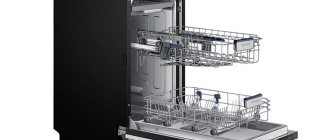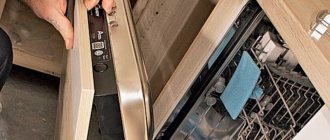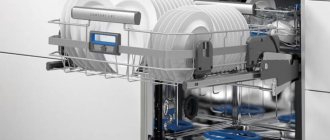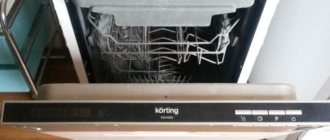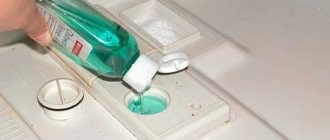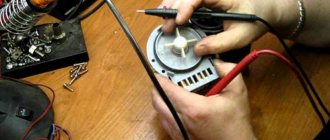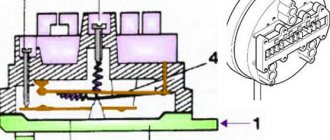The main causes of breakdowns of the Hotpoint Ariston dishwasher
It is always better to find out the cause of equipment failure yourself. This will be useful for home repairs and when calling for service. This way you will know that the masters are not imposing unnecessary expenses on you.
The location of the breakdown can be determined by external signs and malfunctions of the machine. Also, the equipment itself can report a malfunction by highlighting a code on the display. If your control panel has a screen, then the code will appear as a combination of letters and numbers. A panel without a display will indicate a problem by flashing indicators.
Here are the main error codes:
- AL01 (indicator 1 or 3 lights up) - the “Aquastop” leakage protection is turned on;
- AL02 (2-4) - water does not enter the hopper;
- AL03 (1-2/3-4) - waste liquid does not leave the tank;
- AL05 (1-3/3-5) - problems with the operation of the circulation pump or pressure switch;
- AL10 (2-4/4-6) - heating element circuit malfunction.
The meaning of the code on your display can be found in your instruction manual. If you want to know what to do, take a look at our Ariston Dishwasher Error Codes page.
PMM "Hotpoint Ariston" is similar in structure to Electrolux machines. Their malfunctions can be repeated, but still the following breakdowns are more common in Ariston models:
- The heating element does not work . This reduces the quality of washing; the cycle is carried out in cold water. If the heater penetrates the housing, the plugs may be knocked out when the PMM is turned on.
- The machine does not take in water . You may hear a hum, but no fluid is entering the tank. The cause could be blockages in the intake tract or a malfunction of the intake valve.
- The water intake does not turn off, while the drain is constantly running . Damage to the fill valve or level sensor.
- During operation, noise and hum are heard . The issue may be a blockage, a problem with the engine or its bearing.
- Leak in the car. The worst case scenario is case corrosion. At best, wear of gaskets and seals.
- Water does not drain . The drain, filter, hose or sewer is clogged. Drainage pump failure.
These are the problems users encounter. Let's figure out how to eliminate them.
Possible problems with Ariston dishwashers and current methods for correcting them
Let's see what the machine can tell us in different situations. And we will immediately decide what needs to be done. We will designate the signals as follows: code “_”; “_” – number of indicator blinks for a machine with 4 programs; “_” – number of flashes for machines with 6 programs.
Leakage protection has tripped (code AL01; 1 flash; 3 flashes)
It’s worth noting right away that calling this protection the term Aquastop is incorrect. Even if the dishwasher manufacturer himself does this. And for us, copyright is not an empty phrase. The term AquaStop is an entire protection system that includes solenoid valves and sensors.
The name and the system itself are patented and are usually used in washing machines and dishwashers of the Bosch and Siemens brands. We are watching Ariston. In this situation, the leakage protection of the housing, which is a pan with a float, was activated. When a leak occurs, water collects in the pan and the pop-up float blocks its further movement.
We turn off the water supply and disconnect from the network. What is needed to correct the situation? Carefully check all connections through which water circulates and the tightness of the washing chamber. The tube on the circulation pump may have come loose. The pump can be accessed through the bottom of the machine.
Water does not enter the machine (code AL02; 2 flashes; 4 flashes)
According to the manufacturer, you need to immediately check the water inlet valve. There is no reason not to trust a serious company. It’s just better to start with more prosaic things. First, it’s worth clarifying - is there water in the tap? Is its pressure enough? Any dishwasher has a minimum water pressure level at which it can operate normally.
Otherwise, flooding is impossible. Is there water and pressure normal? Then we check the inlet hose along its entire length. There should be no pinches or bends. If there are, they need to be eliminated. If your inlet hose is equipped with a leakage protection valve, check the indicator of this valve.
Sometimes the indicator is the hose itself (it changes color). If the protection is triggered, the valve blocks the water supply directly near the tap. This type of hose has disposable protection and will have to be replaced with another.
It would be a good idea to check the filter mesh at the entrance to the machine. The mesh may well be clogged with rust or other impurities contained in tap water. If this is not the case, then yes, you need to check the water inlet valve. His nutrition may be disrupted. Checking the wires. If necessary, we replace it with a working one.
Ariston dishwasher does not drain water (code AL03; 1-2 flashes; 3-4 flashes)
Failure to drain is almost always due to a problem with the drain pump or water level sensor. The pump may not work (or not work correctly) in several cases:
- clogged drain filters,
- the pump impeller is blocked,
- the pump is faulty (or the wire could simply come loose).
In the first case, if the machine does not drain the water, you need to remove the filters that are located at the bottom of the washing chamber and thoroughly clean them of dirt.
The filters are washed under running water. The sump pump impeller may also be contaminated with food debris or broken dishes. It is necessary to clean it and ensure its unhindered movement. The impeller should rotate without interference.
To check the functionality of the drain pump, you will have to disassemble the lower part of the dishwasher. After removing the base, access to the internal components of the machine opens. When gaining access to the pump, carefully inspect its contacts. Then you need to check the integrity of the windings with a multimeter.
If the pump malfunctions, you will have to replace it with a new one. And the last possible option is a malfunction of the electronic control module. There is no point in trying to repair it. It can only be replaced.
The circulation pump or level sensor is faulty (AL05; 1-3 flashes; 3-5 flashes)
The circulation pump is the main component of the dishwasher, its motor.
To get to it, you will have to disassemble the dishwasher from below (just like when replacing the drain pump). It is necessary to check all the contacts connected to it. If there are breaks, you need to restore the connections. Check the windings.
Disassembling the pump is problematic. Although there are craftsmen who can do this. May need replacement. The level sensor is located in the same part of the machine.
It may also have loose wires or a clogged tube. Most often you will need to replace it with a new one.
The heating element's power supply is broken (code AL10; 2-4 blinks; 4-6 blinks)
A malfunction of the heating element can cause either a lack of heating of the water or its excessive heating. You can get to the heating element using the same method as for checking the drain pump and pump. It is necessary to check the integrity of the contacts.
Again you will need a multimeter. It is necessary to ring the circuit of the heating element. A faulty heating element must be replaced. Sometimes it may be necessary to check the thermistor installed in the heating element. If necessary, we simply replace it with a working one.
Of course, no machine can diagnose problems absolutely accurately, but it will help to indicate the most likely direction of search. For example, if you saw a message on your car about a malfunction of the heating element, and the service technician claims that you need to replace the motor, drain pump and pressure switch, you can politely tell him: Sorry, but you are wrong!
Or something else. A separate description of how to disassemble a dishwasher for further repairs is not at all difficult to find. And who will do this repair - decide for yourself.
The main causes of breakdowns of the Ariston dishwasher
There may be several reasons why the dishwasher is not working. As mentioned above, you need to pay attention to the “symptoms” of a breakdown. Let's take a closer look:
- PMM Ariston does not heat water. The cause may be a broken heating element. You should check the wiring leading to the heating element, the heater itself and the thermostat. The latter helps measure the water temperature, so if it breaks, it needs to be replaced.
- When the machine does not draw water, you need to check the presence of water in the water supply. Sometimes the reason is a clogged inlet hose or mesh filter. Have you noticed that your dishwasher doesn't wash dishes well? Check the nozzles on the sprinkler, they may be clogged.
- Water constantly fills and drains in the dishwasher. This malfunction indicates problems with the fill valve. Its membrane does not close, so water constantly flows, while the indicator flashes, notifying you of a breakdown. The reason may be the level sensor, which is responsible for monitoring the water in the tank.
- The machine makes noise when operating and the water does not drain. The rocker arms could be clogged, or the pump could be broken.
- The cause of the machine leak could be the drain and inlet hose. Depressurization of the housing or door could also cause water leakage. A thorough inspection and replacement of parts is required.
- Your Ariston dishwasher won't start or turn on? Connect another device to its socket. If it doesn't work, then the socket is faulty. Next, check the onboard switch. Ring the contacts of the switch; if faulty, replace it.
If your car is still under warranty, then you should not solve the problems yourself. It is better to contact a service center.
Dishwasher self-diagnosis
Various machines of this brand have the ability to diagnose various types of faults and inform the user about them using the control panel. Information can be displayed in various ways:
- on the display screen in the form of a special code;
- on the LED indicator of machines with 4 programs;
- on the LED indicator of machines with 6 programs.
In the case of cars without a display, information is provided by a certain number of indicator flashes. For machines with 4 and 6 programs, the fault symbols are different. Therefore, we will consider them as different. The only clarification is that the indication may indicate several possible malfunctions.
Potential culprits
If the Ariston washing machine does not heat up to the specified 30-90 degrees, then it is not a fact that the problem is in the heating element. In addition to it, several other devices and sensors are involved in heating, the failure of which affects the low water temperature. Moreover, often there is no malfunction - it is likely that the user chose the wrong washing program.
Having detected a lack of heating, you do not need to immediately start disassembling the washing machine.
First of all, you should pay attention to the dashboard of the machine and look at the selected mode. Many programs, for example, “Delicate”, “Sportswear”, “Silk”, “Fast”, “Economical”, “Silk”, according to factory settings, should not bring the water to high temperatures. For most Ariston models, even standard washing occurs at 30-40 degrees
For most Ariston models, even standard washing occurs at 30-40 degrees.
If a “hot” program is enabled, then you need to additionally check the set heating temperature. Modern Ariston washing machines offer the user to change factory settings to save energy consumption or speed up the cycle. Probably, a key was accidentally pressed, reducing the degrees to minimum values. Or, conversely, the system did not count the changed parameters due to the selector not working. It is better to scroll the regulator forward a few positions and reboot the equipment. It is possible that a so-called “technical glitch” occurred.
In any case, it is recommended not to turn a blind eye to the suspicious behavior of the machine, but to conduct a rapid test. Cold laundry after washing is not an argument against the heating element, since the final rinse occurs in water without heating. To dispel or confirm suspicions, it is better to use a more reliable diagnostic method:
turn on a program that heats the machine to 60-90 degrees (you can choose 45 degrees, but the difference will not be so obvious); time 20-30 minutes from the start of washing (it is important that the washing machine does not switch to rinsing); put your hand on the door glass; estimate the surface temperature.
If the hatch glass is hot or warm, then there is no problem with heating the water - the system is in perfect order. A cool surface, on the contrary, signals a problem. In the latter case, it is necessary to respond to the signal as soon as possible, determine the causes and extent of the breakdown.
How to repair a dishwasher
In some cases, you can fix the problem yourself. Before starting work, disconnect the Ariston machine from the network and communications. Prepare the necessary tools.
Heater replacement
The heating element often suffers from scale when using hard water. If you hear an unpleasant burning smell, you need to check the wiring of the heating element, which may have burned out. Are you sure that the Hotpoint-Ariston heater is faulty? Then start replacing:
- Open the hatch door where the dishes are loaded.
- Remove all trays and shelves.
- Remove the water spray by pulling it up. It is located at the bottom of the car.
- At the bottom there is a filter that protects the pump from contamination. Unscrew the part and remove the mesh from below.
- Unscrew the bolts that secure the pipe and the heater.
- Place the dishwasher on its side with the bottom exposed.
- If the machine is freestanding, remove the rear panel by unscrewing the mounting bolts. If the device is built-in, remove the bottom.
- A pump is attached to the side of the heating element. You need to unscrew it clockwise. Disconnect the pump wiring and remove it from the housing.
- Disconnect the rubber fastener of the heater and remove the heating element.
Tip: To ensure proper wiring, take a photo of the connectors before removing the item from its socket.
Start the machine after repair to check the operation of the new element.
Checking the water intake valve and level sensor
When water does not flow into the Ariston dishwasher or, on the contrary, it constantly fills, check the intake valve. The part cannot be repaired, so you will need to disassemble the PMM:
- Remove the side or back panel (depending on model) of the dishwasher.
- The valve is located immediately behind the inlet hose.
- Unscrew the valve fasteners and disconnect the wiring.
- For replacement, a part is selected for a specific dishwasher model.
The pressure switch could also be broken. The reasons for its breakdown are natural wear, burnt contacts, and blockages in the pressure tube.
How to disassemble the car and get to the sensor:
- Open the bottom of the dishwasher.
- Find the level sensor. It looks like a box with pipes.
- Unscrew the two mounting bolts.
- Remove the tube from the box using pliers.
- Inspect the tank (box) for pressure.
- Check the electrical part of the pressure switch by measuring the resistance at the contacts.
- If damaged, install the new part in reverse order.
It’s easy to make the replacement yourself. Be careful and follow the recommendations.
Pump replacement
Below are instructions for replacing the dishwasher drain pump. The main thing in this repair is to properly disassemble the dishwasher.
- Open the machine's hopper door.
- Empty the hopper of shelves and baskets.
- Pull out the bottom filter, as well as the metal mesh.
- Unscrew the inlet hose.
- With the machine on its back, remove the bottom cover. To do this, unscrew the screws around the perimeter.
- Disconnect the wiring connectors from the pump.
- Use pliers to loosen the clamp on the drain hose. Disconnect it from the pump.
- Unscrew the fastening screw and remove the pump assembly.
- Reinstall the new pump with the rubber seal. Connect the wiring.
How to repair Ariston dishwashers
When something goes awry in the usual rhythm of life, it unsettles you, spoils your mood and makes you want to immediately go and fix everything. Now, with your own hands.
For example, imagine a situation: you loaded the dishwasher with dirty dishes, set the timer to turn on, and went about your business.
READ MORE: Repair of Beko washing machines in Balashikha with home visits
And when they returned, opening the door, they again saw all the dirty plates in full, or some other problem that clearly demonstrated that the machine was broken.
Ariston dishwasher repair
And the search for a solution to the problem begins: friends call to complain about broken household appliances and ask if they know anything useful about repairing dishwashers. Then the heavy artillery comes in: the same question is asked on the forum, and finally, a search query is typed: “do-it-yourself Hotpoint Ariston dishwasher repair.”
Ariston dishwasher repair
What to do if the dishwasher does not work - DIY repairs
A dishwasher is not as complicated a piece of equipment as it seems at first glance. Most breakdowns are caused by simple reasons. Eliminating them does not require high qualifications or special knowledge. If the equipment is no longer under warranty, you can try to repair it yourself. We will describe the main malfunctions of dishwashers and how to eliminate them further. In most cases, the causes and methods of elimination do not depend on the brand of the machine. Bosch, Siemens, Samsung, Electrolux, Miele, Indesit, Candy, Beko - it doesn’t matter. The repair is the same. The disassembly process, fastening, etc. may differ. But the basic principles of finding the causes and troubleshooting dishwashers are the same.
A dishwasher is every housewife's dream
How does a dishwasher work?
To repair a dishwasher, you need to understand the processes that occur in it. This is the only way to determine the possible causes of the breakdown and eliminate them as soon as possible.
Let us describe the general principle of operation of a dishwasher. The operating algorithm is usually the same for all manufacturers, although some changes may occur. Next, we will describe the most time-consuming process - washing dirty dishes with time to “acidify” the remaining food.
- After loading the dishes, the door closes. This is recorded by a special sensor. If the lock is not closed, the dishwasher will not start.
- The user selects the dishwasher operating mode and presses the “Start” button.
Rinse water is supplied from all sides
Water is supplied from the nozzles under pressure
As you can see, a large number of sensors are involved in the process. All of them can fail and cause a breakdown. Filters, nozzles, and sprinklers may also become clogged. All these are causes of failure.
Is it worth calling a specialist?
Most machine malfunctions are of a domestic nature and can be resolved without the intervention of a specialist. For example, if the drain system is clogged, you can clean it yourself, following simple instructions. But if a complex failure occurs or an important component is damaged, it is better to contact a specialist for help.
Today, Hotpoint Ariston dishwasher repair service is not an expensive pleasure. The brand's official service centers are located in different cities, and the ability to communicate via a hotline allows you to call a technician who will repair the dishwasher at home.
If you notice problems with your dishwashers, you cannot ignore them. It is better to immediately determine the cause of the breakdown and take the necessary measures.
Breakdowns, possible causes, elimination
Many dishwasher breakdowns can be resolved with simple steps. Often problems are associated with low voltage in the electrical network or low pressure in the water supply. Many breakdowns are explained by the fact that filters, grilles, and openings are clogged with food debris. All these reasons can be eliminated independently, restoring functionality.
The dishwasher does not draw or drain water - you can figure out the reasons yourself
We check at the very beginning and if the PM does not start working
Many malfunctions of dishwashers are explained by simple reasons - a drop in voltage in the network, insufficient water pressure, clogged filters, etc. At the very beginning, after we have discovered that the dishwasher is not working or is working abnormally, we check:
- Voltage - should be 220 V with a slight deviation.
- Cord condition. If there are visible problems, check the integrity of the cord.
Problems with the cord - a possible dishwasher malfunction
These are very simple steps, but it is for these reasons that the dishwasher often does not start working.
Water leak
Some dishwasher problems are caused by water leaks. Then the dishwasher stops during operation and no longer responds to commands. One of the combinations also lights up, signaling a breakdown, but each manufacturer and even each model has its own. But the result is the same - during the washing process (no matter at what stage), the car stops and no longer responds to any signals. Sometimes it can be started again. But after turning it on, it stops again.
The fact is that there is a leakage protection sensor in the pan - it is a polystyrene float. When water appears in the pan, it rises and a contact closes, which is perceived as an emergency signal. Everything is logical - if water appears in the pan, then something is going wrong. This float prevents flooding of your apartment and neighbors below.
Here are the possible causes of PMM water leaks:
- The dishwasher is not level and water is overflowing over the edge of the reservoir.
- Using too much detergent resulted in a lot of foam. Also, do not use a product that is not intended for dishwashers.
- The machine takes in too much water - problems with the water level sensor. During the washing process, open the machine door and make sure that water does not overflow. If there is too much, replace the sensor.
Polystyrene float - leakage sensor
Sometimes a water leak in a dishwasher is a result of a leak in one of the parts. Then you need to remove the back wall of the dishwasher and carefully inspect all the parts. There may be a leak in the hose, a connection that has lost its tightness, etc.
No drain
There are malfunctions of dishwashers of the opposite nature - the PM does not drain the water. There are reasons of a different nature. This type of breakdown is often associated with a clogged drain hole or hose. Here's what it could be:
- The drain hose is pinched or a waste plug has formed in it.
- The drain hole is clogged. Unscrew the protective mesh, pull out the sediment filter, clean it and rinse it of food debris.
- The drain is clogged and the water just won't drain.
- Residues of food have jammed the pump.
To remove the filter in the dishwasher - you need to know how (you can read the manual), but usually it can be unscrewed
If the problem is a clogged machine, the first step is to clean the drain and filter. Next, remove the pump cover. This is a plastic cover secured with bolts (bolt). In some brands it is secured with latches. We clean the impeller and impellers (holes for spraying water). In general, we remove all residues and dirt that catch our eye. The cleaner the machine is, the less likely it is to have another shutdown.
If you are repairing a dishwasher yourself and have little experience in this matter, take photographs of the position of all parts and pieces before you begin to disassemble the unit. It will be easier to restore everything. Even if it seems like there is nothing to forget.
We install everything in place and turn on the car. The water flow should be restored. If not, the problem may be with the pump. It does not pump water and should be replaced.
No water coming in or not enough water being collected
Dishwasher malfunctions are often water related. And one of them is that you don’t get enough water. It could also be that the detergent is not washed off and does not rinse well. All these dishwasher malfunctions can be caused by one reason - insufficient pressure. It is checked first. The pressure in the system must be above the minimum threshold at which the PM can be operated (found in the passport). If the pressure is normal, there may be the following reasons for this failure:
- The faucet on the outlet to the dishwasher broke. Turn off the water, remove the hose, place a container, and turn on the water. Everything is fine - let's move on.
- The inlet valve is clogged. Unscrew the hose, remove the filter with pliers or tweezers, clean and rinse the filter.
To check whether the lack of water is really the reason for the shutdown, pour water inside and start the unit
To make sure that the problem is in the water supply system and not in others, pour 4 liters of water into the machine, load some dishes and start it up. If the machine does not clean, there is likely a problem with the dishwasher control.
Doesn't wash well
Sometimes, after some time after you start using it, you notice that the dishwasher does not wash dishes as well. Such malfunctions are usually associated with violation of operating rules, but there may also be technical problems. So, what could be the reasons that the quality of washing dishes has deteriorated:
- Insufficient amount of detergent (occurs after purchasing a new detergent).
- The dishes are not stacked correctly.
- The heating element has burned out, the water is not heating up.
- The filter-sump is clogged (the process is described above).
Troubleshooting dishwashers: cleaning the drain and water injection holes is never a bad idea
Dishwasher malfunctions due to deterioration in quality can also be caused by control failures. If you have checked all possible causes and there is no improvement, follow the process. You may be able to figure out why your dishwasher has gotten worse at cleaning dishes.
Knocks out the circuit breaker
Dishwasher malfunctions associated with electrical problems usually appear after power surges. Then the control also crashes. Therefore, during installation, it is advisable to take care of installing a stabilizer. If not general - for the whole apartment or house, then at least local. This could be a low-power unit for connecting a dishwasher, or maybe a more powerful one, to which you can connect several electronically controlled appliances.
Electrical diagram of a dishwasher
If, when you turn on/start the dishwasher, the circuit breaker in the panel is knocked out, the reasons may be the following:
- The heating element has burned out.
- Short circuit of the wiring inside the PM.
- The seal is broken and water gets into the parts.
- Voltage fluctuations in the network.
Identifying the exact cause of most of these faults (other than seal failure) assumes that you know how to use a multimeter. Take the electrical diagram of the dishwasher, first check the condition of the fuses, then follow the diagram.
These are, perhaps, all the main malfunctions of dishwashers that you can fix yourself. If these measures do not help, you will have to resort to the services of specialists.
Installation instructions
The dishwasher can be free-standing, built into the kitchen furniture (in a set, under the countertop) or, if it is small in size, in a desktop version. In any case, you must follow the first installation rule: the equipment must be level. Leveling will help reduce vibrations during operation and, as a result, movement of the machine. And this already affects the readings of individual sensors, for example, those responsible for the water level.
It is necessary to comply with certain requirements for the installation of household appliances. It is better to place the dishwasher close to the water supply and sewer lines.
The electrical outlet must be located within the length of the power cord and must be grounded. It is necessary to comply with the design of the socket and plug.
User manual
The user manual is a kind of “bridge” between the owner and the equipment itself. If you have a Hotpoint Ariston dishwasher, the operating instructions for this unit in a concise form reflect the main recommendations for using dishwashers (DMM) in everyday life. Before you start using the equipment for its intended purpose, you need to carefully study its features. Any sentence in the instructions carries a specific semantic load; there are no unnecessary words in it. You need to start with a description of the PMM device. Knowing the location and purpose of the components is a necessary condition for using the machine.
Loading baskets with dishes must follow certain rules for the machine to operate efficiently.
- Many housewives know that removing food debris from plates and pots is a must.
- It is also important to place items in baskets; it should not contribute to the accumulation of water on it. Loading the PMM with dishes should not interfere with the free rotation of the spray nozzles.
- The operating modes of the machine also take into account the properties of the materials from which the dishes are made. For example, thermoplastic products should be placed in the upper basket, with a lower temperature.
How to properly use special products during the washing process - this is also given space in the operating instructions. All dishwashers are equipped with water softeners. The quality of dishwashing depends on the hardness of the tap water. Regenerating salt, which is added to the softener, removes lime from the water that might otherwise remain on the surface of the dishes.
Detergents in PMM are used only specifically intended for it - just like washing powder for automatic washing machines. They can also be used to facilitate drying. Available in powder or tablet form. Then connecting the tray with rinse aid to the operation may not be necessary. If, however, the rinse aid is used to eliminate streaks and stains during drying, the order of its use is clarified during the work process.
Maintenance and mandatory care of the dishwasher are described in the instructions.
There are also tips on how to repair the unit with minor damage. Regular cleaning of filters and sprinklers is the basis of routine maintenance. For periodic cleaning of scale, food residues and grease, it is better to use universal detergents for dishwashers and washing machines.


